Asplund
The term nybrutalism, new brutalism, was the jocular coinage of architect Hans Asplund. He applied it to a small house in Uppsala, in his native Sweden, designed in 1949 by his contemporaries Bengt Edman and Lennart Holm and built of bricks. Were it not for that material, the house might stand as the very example of the light, ascetic, prim, nordic modernism that afflicted Britain for some years after the war. The Festival of Britain in 1951 was actually The Festival of Plagiarising Scandinavian Architecture.
Asplund's neologism caught on in Stockholm and was picked up by British architectural pilgrims to that city, among them Oliver Cox, Graeme Shankland and Michael Ventris, the decoder of Linear B (an ancient script seen as one of the great linguistic riddles). Although the epithet signified nothing, or maybe because it signified nothing, it was taken up as a slogan of defiance or something by arty young British architects, none artier than Alison and Peter Smithson and their representative on Earth, Reyner Banham, an architectural critic whose prose may cause all but the entirely insentient to wince. The Smithsons' Hunstanton School in Norfolk, finished in 1954, derives from Mies van der Rohe and has little in common with subsequent buildings that were deemed brutalist.
Béton brut
Banham expanded Asplund's coinage, turning it into a bilingual pun on the French béton brut – literally raw concrete. Exposed concrete, left rough and unfinished, would become the defining trait of brutalism. So Banham, with his weakness for feeble wordplay, linked brutality with concrete, even though there had been concrete structures since the Romans, most of them pacific. The shared etymology of brut and brutal was unfortunate. Monoglot opponents of brutalist buildings – knowing nothing of béton brut and apprised only of the English component, brutal – were handed the ammunition of what seems like a boast of culpable aggression. Or maybe not: the French, to whom the pun was clear, have been no more appreciative of their brutalist buildings than the English.
Cité Radieuse
Before the war, Le Corbusier's work was sleek, smooth, right-angled, rational. Postwar, he led the reaction against such architecture: he dumped a technical manual in favour of ecstatic poetry. La Cité Radieuse in Marseille, aka l'Unité d'Habitation, was the first of his exercises in sculptural and plastic moulded concrete which, in spirit if not style, have affinities with the primitivist tendency of the arts and crafts. L'Unité gave the word brutalism a meaning. Le Corbusier ripped off countless other artists and architects, notably Fernand Léger, Pablo Picasso and most importantly Friedrich Tamms. Indeed, his later oeuvre can be viewed as a synthesis of thefts. Le Corbusier never applied the word brutalist to his own work.
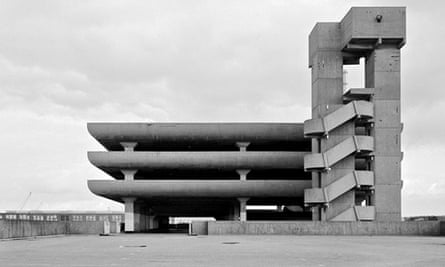
Dystopia
Brutalism is the decor of dystopian films, literature and comics, just as gothic is for horror. See Alphaville, A Clockwork Orange, Blade Runner, Get Carter, La Haine. Books and films have of course impinged on the way brutalist buildings have been judged down the years, assisting in their condemnation. They have been found wanting beside the holyhocked cottages and winking dormers beloved by Blighty.
Expressionism
Brutalism, as Nikolaus Pevsner pointed out with some distaste, had its roots in expressionism, the jagged, often counter-intuitive, mostly brick idiom that flourished in the Netherlands, Germany and the Baltic states from 1910 to 1930. Its greatest exponent was Michel de Klerk, whose social housing projects in Amsterdam retain, a century after they were made, a beguiling freshness. Its kitschiest exponent was Bernhard Hoetger. His Böttcherstrasse in Bremen, a street 100m long, was commissioned by the inventor of decaffeinated coffee, Ludwig Roselius, who dedicated it to Adolf Hitler. At the 1936 Nuremberg Rally, Hitler showed his gratitude by declaring it decadent.
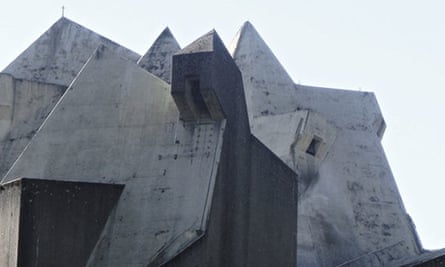
Förderer
Vatican II was a godsend to architects. The Roman Catholic church was a generous, adventurous patron, and its buildings were to be advertisements for the church's newfound modernity. With few functional demands to take into consideration, architects enjoyed carte blanche. God can, apparently, live anywhere – and in the 1960s, he shared the widespread taste for open-plan spaces and theatre-in-the-round.
The boundary between architecture and sculpture, which Le Corbusier had broached, was now comprehensively trampled. The architects who most took advantage of this were Walter Förderer in Switzerland and Germany, Gottfried Böhm in and around Cologne, and Fritz Wotruba in Vienna. Their work defines brutalism. It is accretive, ostentatious, hyperbolic in its asymmetries and protracted voids, composed of parts that do not connect or are in a fragmentary state, dramatically vertiginous, geometrically farouche, extravagantly cantilevered, discomfiting, aggressive (in so far as an inanimate object can be aggressive).
There is no desire to please with prettiness or even beauty. The reaction demanded is that of awe. The quality that the greatest brutalist buildings manifest is sublimity.
Geology
Brutalist architecture did not seek to represent geological formations. It sought to create buildings that matched such formations, even challenged them. Mankind could take on nature and win, could make its own yardangs and hoodoos. Half a century ago, mankind lorded it over the earth. The practices of being friendly to vegetables and minerals, and of granting rights to animals were far in the future – though they had, of course, been de rigueur in Germany for 12 years, from the Nazis' seizure of power to their defeat.
H
To anyone under the age of 50, brutalism belongs to the age of their non-existence. It is something that happened in history, while postmodernism is still with us. But now, having ransacked all other dressing-up boxes, architects have gradually turned to brutalism for inspiration. The most prolific is Jurgen Mayer Hermann, who trades as J Mayer H. His border checkpoints and service stations in Georgia might, at first glance, be taken for works of the 1960s – they are uncompromising, assertive, convinced of the artist's right to impose his vision without consultation, without accommodating consensual taste.
Imperial College London
Sheppard Robson's magnificent hall of residence in South Kensington was finished in 1963 and demolished 42 years later. It is not shown on the practice's website. Nor are its slightly later and happily extant lecture halls at Brunel University. Are its current architects embarrassed by their predecessors' work? Uneasy about how potential clients might react? Imperial College has form in this area. Some professor of a "discipline" called Sustainable Energy in Business defends the destruction of cooling towers thus: "You have to think: how much does this enhance the landscape compared to what else we could do if we weren't having to maintain the towers?" This is the very epitome of unreflective short-termism and a not-particularly-convincing justification for sanctioned vandalism.
Jasari
The School of Advanced Proxenetism, in Albania's capital Tirana, was designed by the late Nexhat Jasari, whose other works included soundproofed containers, experimental dungeons and the Presidential Bison Run.

Konstantinov
Skopje – in Macedonia, then the southernmost Federal Republic of Yugoslavia – was largely destroyed by an earthquake in July 1963. The masterplan for rebuilding the city was undertaken by the Japanese architect Kenzo Tange. Most of the actual buildings were designed by Yugoslav architects, among them Janko Konstantinov, whose post-office complex presages the wild and delirious spomenik memorials to the National Liberation War (ie the second world war). President Tito commissioned scores of these futuristic melds of architecture and sculpture, some of which have been recorded by Belgian photographer Jan Kempenaers. Many, however, were destroyed during the 1990s civil wars.
Konstantinov's work also presages the weirdly joyous style of the later years of the Soviet satellites, the Leonid Brezhnev Plays Las Vegas school of architecture. Much of this has been recorded by the French photographer Fréderic Chaubin.
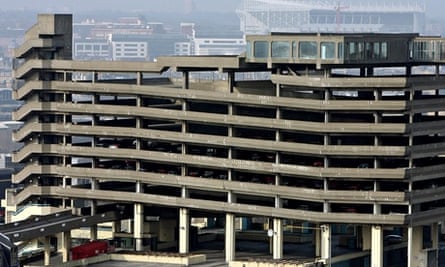
Luder
The three finest works of British brutalism were designed by Rodney Gordon of the Owen Luder Partnership. They were: Eros House in Catford, London; the Tricorn in Portsmouth; and the Trinity in Gateshead. The first, a block of flats, is disfigured; the other two shopping centre and car park complexes have been destroyed in acts of petty-minded provincial vandalism. One can have nothing but contempt for the scum-of-the-earth councillors, blind planners and toady local journalists who conspired to effect the demolition of such masterpieces. One can only despair at the pusillanimous lack of support from wretched English Heritage.
The dependably crass Prince of Wales, the man who sullied Dorset with Poundbury, described the Tricorn as "a mildewed lump of elephant droppings", a simile as vulgar as it is visually inept. No doubt his heritage industry toadies removed their tongues in order to chortle a moment's laughter. The critic Ian Nairn was on the money: "This great belly laugh of forms ... the only thing that has been squandered is imagination."
Gordon's imagination was indeed fecund, rich, untrammelled. It was haunted by Russian constructivism, crusader castles, Levantine skylines. But the paramount desire was to make an architecture that had not previously existed. There are as many ideas in a single Gordon building as there are in the entire careers of most architects. The seldom-photographed street level stuff at the Trinity left the observer with the sensation of being in the presence of genius. One thinks of the burning of books.
Monstrosity
It took more than three-quarters of a century before high Victorian architecture began to be rehabilitated through the efforts of John Betjeman, Evelyn Waugh, etc. Their pleas went unheeded. They were reckoned to be perverse and mischievous. Thousands of "monstrosities" were destroyed. The survivors are now widely valued, and lost ones are mourned. We have learned nothing. Half a century after brutalism's heyday, the term "concrete monstrosity" trips readily off the tongues of the unseeing, the torpid, the incurious. Britain is once again being architecturally cleansed in favour of timidity and insipidity.
New
Newness and change were bound to be for the better. When Harold Macmillan announced in 1957 that "most of our people have never had it so good", some of our people were still living in caves (in the Severn valley), and many of our people had no bathrooms and shared outdoor toilets. Built along brutalist lines, new flats had all those amenities, plus central heating, and were welcomed by their occupants. Social-housing projects were not yet bins for sociopaths. But they would soon become so: if blocks are unguarded, if there are no janitors, if they are not maintained … You don't buy a car and never get it serviced.
Organisation Todt
The Nazis' civil-engineering arm, named after Fritz Todt, built motorways and arranged their surrounds in order to achieve minimal damage to the landscape. These animal-lovers were nothing if not green. From the outbreak of war, its work was almost entirely martial. After Todt's death in 1942, the OT was directed by Albert Speer. Its architects included Werner March, author of the 1936 Berlin Olympics stadium, and the startlingly prolific Friedrich Tamms, who created the designs for 60 different types of gun emplacement, bunkers, shelters, flak towers, U-boat bases, etc. Tamms was, arguably, the first brutalist. He revived the expressionism that the Nazis had proscribed. The forms he used were seldom functional. Rather, they employ the imagery of might – vizors, chainmail fists, anthropomorphism and zoomorphism. They were terrifyingly graphic warnings to the people of occupied countries.
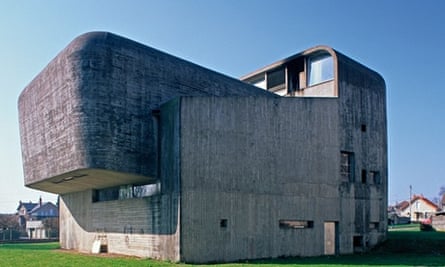
Parent
The church of Saint Bernadette in Nevers, France, consecrated in 1966, is the work of architect Claude Parent and theorist Paul Virilio. For some years, they had been studying the thousands of structures that comprise the Atlantic Wall, the coastal fortifications built – by slave labour – along the west of Europe from 1940-44. The similarities between these structures and brutalist architecture had been brushed under the carpet. In their huge bunker-like church, Parent and Virilio make the link explicit.
Quebec
Canada's most extreme examples of brutalism are in Quebec City, which boasts Dimitri Dimakopoulos's boorish Concorde Hotel; and in Quebec Province, home to Moshe Safdie's thrilling Habitat 67, a collision of 150 residential units in Montreal that appear to teeter perilously. The effect is both fragmented and monolithic: a labyrinth made by termites with an eye for right angles.
Robbins
The Committee on Higher Education, chaired by economist Lionel Robbins, sat from 1961-63. Its report recommended a massive expansion of tertiary education. New universities were to be built. Old universities and colleges were to be extended. One reaction was Kingsley Amis's observation that "more will mean worse". Another was delight on the part of architects who saw an incomparably rich gravy train approaching. Denys Lasdun's University of East Anglia is perhaps the finest of the lot. The Roger Stevens building at Leeds – by Chamberlin, Powell and Bon – is agreeably weird.
One minor nail, a drawing pin, in brutalism's coffin was its rapid espousal by the Wilsonian establishment, which caused half-witted spartist protest-kids to identify it with repressive authority.
Soreq
Those protest-kids have no doubt directed many howls of self-righteous anger at the Soreq Nuclear Research Plant in Israel. The architect was Philip Johnson who, in his long life (he lived to 99 and never retired), had jumped on many bandwagons and even started a few. One of this creepy socialite's many enthusiasms was Hitler, which makes an Israeli commission a matter of wonder. While his brutalist buildings in the US are as unconvincing as most of his oeuvre, this temple to radiation on the dunes a few miles south of Tel Aviv is impressive. Brutalism was the cold war's architectural mode, on both sides of the Iron Curtain – Mutually Assured Construction.

Tange
Kenzo Tange's viscerally exhilarating Yamanashi press and broadcasting centre in the Japanese city of Kofu is a vast machine that seems to be missing vital parts. His Kuwait embassy in Tokyo might have been assembled from several vaguely similar extant buildings, while the Shizuoka press centre is all cages attached to a stout pole. Elsewhere, Tange hangs cantilevers at oblique angles and creates buildings that look as if they are in the process of collapsing.
Utzon
The Danish architect Jørn Utzon is celebrated for the Sydney Opera House. His essays in brutalism were failures, tentative and timid. Indeed, this was an idiom for which Scandinavians seemed to have had no stomach. A tragic lack of insensitivity and an excess of rationality no doubt militated against its adoption.
Vanbrugh
The proto-brutalist John Vanbrugh's buildings were widely lambasted while he was still alive. Blenheim was described as "a quarry". When he died, the Reverend Abel Evans famously wrote: "Lie heavy on him earth! For he /laid many a heavy a load on thee."
World's End
This estate of seven London towers, between King's Road and the Embankment, was designed by Jim Cadbury-Brown and Eric Lyons. More than any other London scheme, it demonstrates brutalism's debt to expressionism, explicitly that of Hamburg and Bremen. It is restless, angular, red brick, complicated. Cadbury-Brown's earlier work included the Royal College of Art, an equally commanding presence.
X
Team X was a loose grouping of youngish architects, manifesto folk, who in 1953 broke with CIAM (Congrès International d'Architecture Moderne) to pursue a less rational architecture – in other words, they had understood the prevailing change of mood. The group included Le Corbusier's collaborators Shadrach Woods and George Candelis, who had been instrumental in changing that mood, and the Smithsons. In Rachel Cooke's Her Brilliant Career, there is a photograph of the teenage Alison Smithson. At first glance, it appears to be Kevin Rowland in Dexy's ragamuffin period. This is worrying.
Yale
Paul Rudolph began his career, in Florida, by designing light and airy houses, mostly of modular construction. He moved from these chamber pieces to full-blown and very noisy symphonies: massive, lumbering, sullen campus buildings that manifest a spectacular indifference to what anyone thinks of them. This is sod-you-ism at its most stubborn. One is obviously led to think of clumsy robots sodomising each other. Rudolph was dean of Yale's architecture school and author of that faculty's building. Among his pupils were Richard Rogers and Norman Foster. Photoshop Rogers's Lloyds building and render it as though it were built of concrete.
Zapotec
During the 1920s, there was a California craze for neo-Mayan architecture or, more precisely, exterior decoration. The pre-Columbian modes that attracted attention in the 1960s were the Zapotec and the Inca: massive, bold, cyclopean, devoted to 45° slopes. Where building ends and natural formations begin is often moot.
Jonathan Meades's Bunkers, Brutalism, Bloodymindedness: Concrete Poetry starts on BBC4 at 9pm on Sunday.
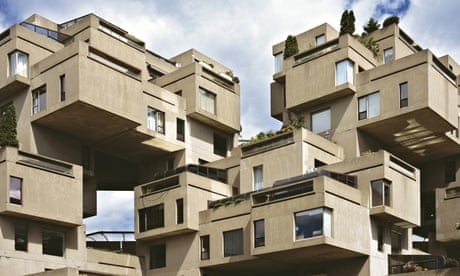
Comments (…)
Sign in or create your Guardian account to join the discussion